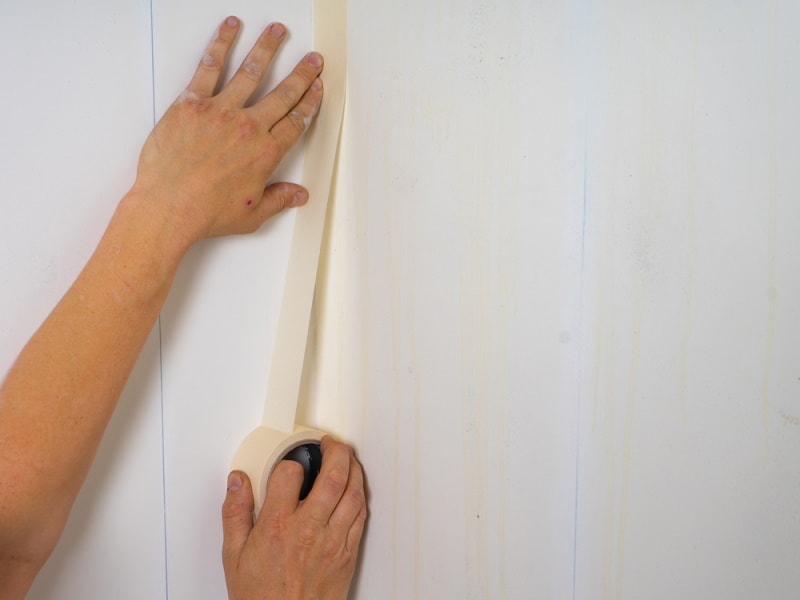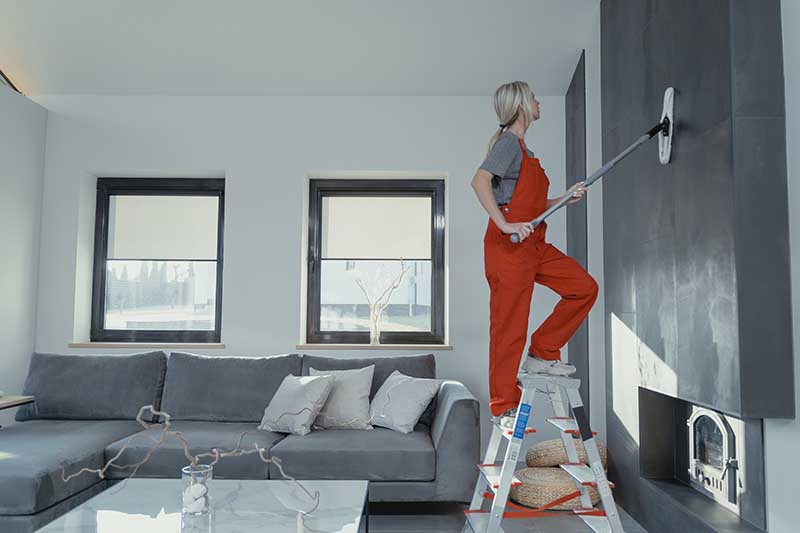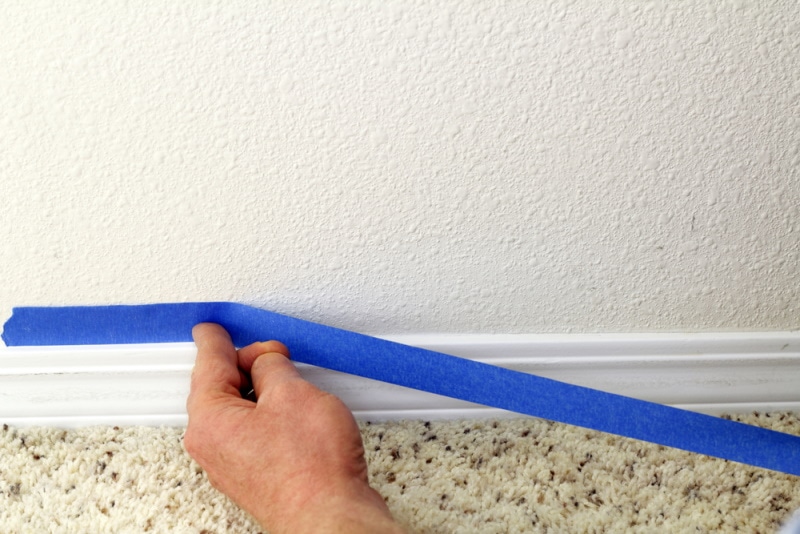How to Remove Adhesive Tape From Walls: 3 Tips & Tricks
-

- Last updated:

Adhesive tapes have proven to be beneficial in a variety of ways. Sometimes we need them temporarily, while other times, we want them to stick and stay on the walls to mount items like picture frames, lightweight artwork, or wall hooks.
However, the problem with using adhesive tape is sticking to the walls. Sometimes they stick to the point that you cannot remove them without pulling off the painting. Some types of adhesive tapes are designed with pull tabs to make it easy when removing them from the wall.
Do not fret. Continue reading to learn more about removing adhesive tape from the wall.
Before You Begin
Before you begin removing adhesive tape from the walls of your home, certain things must be ready for the entire process to run smoothly. Preparations may also depend on the type of method you have decided to use. Below is a simple preparation procedure to keep in mind.
- Get the needed items. If you are for DIY, know the materials needed to safely remove adhesive tape from walls. Apart from the requirements, you also need to know the procedure and other alternative methods so that you can choose the method that best suits you.
- Cover and move the furniture. Moving your furniture may not be necessary if the adhesive tape is only on a small part of the wall but covering them is essential. You wouldn’t want to create a mess by pouring some adhesive removers on your seats. Other adhesive removers are powerful; they may discolor your furniture. You may also be required to cover the floor next to the wall you will be working on.
- Plan for cleaning and rinsing. Once you have successfully removed the adhesive tape from your wall, you must ensure the place is clean. Therefore, prepare a cleaning bucket, water, soap, or sponge. If you are working on a glass wall, equip yourself with some window spray, a clean, soft cloth, and some rubbing alcohol.
- Get ready to deal with adhesive residue. When removing adhesive tape from the wall, there are minimal times when the tape just comes off without leaving some residue. It would help if you were prepared with some sticky residue removers from the store or homemade ones. If you plan to use a homemade adhesive residue removal, ensure you have water, liquid soap, and vinegar.
- Prepare for possible damages caused by adhesive tape removers. Suppose the painting on the wall where an adhesive tape was being removed has been damaged, ensure you have some coat primer which you will apply on the damaged surface. Also, make sure you have paint matching the same wall color. After using your primer, you will need to add two coats of paint over it and allow it to dry up.

The 2 Methods on How to Remove Adhesive Tape From Walls
Suppose you want to remove adhesive tape from your wall; the two methods illustrated below will guide you. The requirements are simple items that can be easily accessed from your home.
Method One: Peel Away the Tape & Clean the Adhesive
Materials
- Flat blade/butter knife/credit card or plastic spatula
- Eyeglass cleaner
- Nylon scrubber
- Adhesive tape
- Clean cloth
- Rag
- Lift the edge of the adhesive tape. Depending on the item you have at your disposal, be it a flat blade/butter knife/credit card or plastic spatula, identify the leading edge of the tape that can easily be lifted and slowly slide your gadget below the surface of the tape.
- Pull the adhesive tape. Gently use your fingers to get under the adhesive space and pull. There are times when gentle pulling will work; other times, you may need to pull off the tape too fast.
- Get rid of any remaining pieces of adhesive tape. When peeling off the adhesive tape, a piece may remain attached to the wall while the rest peels off. The best way to deal with this is to stick new adhesive tape over the remaining pieces and pull it off.
- Deal with the remaining adhesive residue. The new adhesive tape will not just deal with the remaining stubborn piece of the tape; it will also contribute to removing any remaining adhesive residue attached to the wall. A simple rub over the remaining adhesive with your thumb can also remove it. However, if it does not work, dip a clean cloth in an eyeglass cleaner and gently rub it over. The eyeglass cleaner contains alcohol, making it perfect for removing adhesive from the wall. However, ensure the alcohol does not go beyond where the residue is situated, as it may cause damage to the painting on your wall.
- Wipe off the adhesive. With a clean, dry rag, gently wipe off the loose residue of the adhesive and allow the wall to dry.

Method 2: Heat Tape & Adhesive First
Materials
- Hairdryer
- Butter knife or pallet
- Water
- Vinegar
- Soap
- Scouring pad
- Mixing bowl
- Sponge
- Loosen the tape using a hair dryer. Ensure you have a power source close to where the adhesive tape must be removed so you can easily access it. Plug in the hair dryer and ensure the settings are at high power. Hold the running hair dryer over the adhesive tape, and let it not be too close so the hot air can blow over it. Ensure you focus hot air on a single tape corner to loosen the adhesive on that specific part.
- Pull the adhesive tape. Use your butter knife, palette, or fingers if you have long nails to pull off one edge of the adhesive tape. In this case, it is the corner that you had to ensure more hot air from the dryer blew over. The hot air softened the adhesive between the tape and the wall, making it easy for you to peel off the tape.
- Remove the adhesive residue. Once you have successfully pulled off the adhesive tape from the wall, there is a high chance that some sticky residue will still exist on it. You may consider using the scouring pad, warm water, and some liquid soap to buff the surface and eliminate the residue.
Alternatively, you could take your mixing bowl, add some water, vinegar, and liquid soap and ensure they thoroughly mix. Dip a clean sponge into the solution and wash the area where the adhesive residue still exists in a circular motion. The solution may, however, cause a slight fading on the painting on your wall.

The 1 Method on How to Remove Adhesive Tape From Glass Walls
Removing adhesive tape from a glass wall slightly differs from removing it from a usual concrete wall. For instance, when dealing with a glass wall, you may reconsider using heat tactics to protect the glass. Also, cleaning sponges that are too abrasive should be avoided to limit the possibility of causing scratches.
You can easily remove adhesive tape from a glass wall with the method illustrated below.
Materials
- Glass cleaner
- Butter knife
- Cleaning sponge
- Rubbing alcohol
- Cooking oil (olive oil)
- Soft, clean cloth
- Remove the adhesive tape. Since we are dealing with a glass wall, you will need a butter knife to pick at one of the corners of the adhesive tape. You do not have to use the knife if you have longer nails. Ensure you peel off as much tape as possible from the glass. Be careful not to scratch the glass wall.
- Spray some glass cleaner. The glass cleaner will help soften the adhesive residue still stuck on the glass wall’s surface. Suppose you do not have a glass cleaner; mix some water, vinegar, and liquid soap.
- Use a sponge to scrub the soaked surface. Once you have used your glass cleaner on the glass surface with adhesive tape, gently continue scrubbing the area with a soft sponge. The sponge will dislodge the glue residue still holding onto the glass wall.
- Use cooking oil. Suppose the above trick does not work; that is when you bring in the cooking oil. Spray the oil on the affected area and use the soft sponge to continue rubbing it gently.
- Use your rubbing alcohol to rinse the glass wall. Take a soft, clean cloth and dip it in rubbing alcohol. Rub the cloth on the glass wall to eliminate the already softened adhesive residue and the cooking oil. Once done, allow the oil to evaporate without leaving any marks.

Helpful Tips When Removing Adhesive Tape From the Walls
1. Always Test Commercial Adhesive Tape Removers Before Use
Commercial adhesive removers are believed to be efficient and work very fast. However, some of them are made of powerful chemicals that will immediately remove the adhesive tape from the wall and remove the wall painting in the applied area. Therefore, try testing them on an inconspicuous surface before using them on a painted wall.
2. Keep Off Oil-Based Adhesive Tape Removers
Oil-based adhesive removers will disappoint you by leaving a huge stain on the wall. The stain will not only bleed through the wall but will also remain permanent even when the wall is repainted.
3. Opt for Alcohol-Based Adhesive Tape Removers
Alcohol-based adhesive tape removers do not form any stains or tamper with the color of your wall. They clean and evaporate without causing any permanent damage.

Conclusion
There are several methods of removing adhesive tape from a wall. However, it all depends on whether you are dealing with a concrete or glass wall. For either type of wall, you must prepare for the process and what comes afterward. For instance, know how to remove the adhesive tape and the sticky residue left after the tape has been removed.
Overall, the procedures described above should help you deal with adhesive tape removal from the walls. However, should you not be able to get it right, you may consider hiring professional cleaning services.
Related Read:
- How to Get Tape Residue Off a Car Without Damaging It — 8 Tips and Tricks
- How to Remove Adhesive Tape From Walls: 3 Tips & Tricks
Featured Image Credit: Angurt, Shutterstock
Contents

